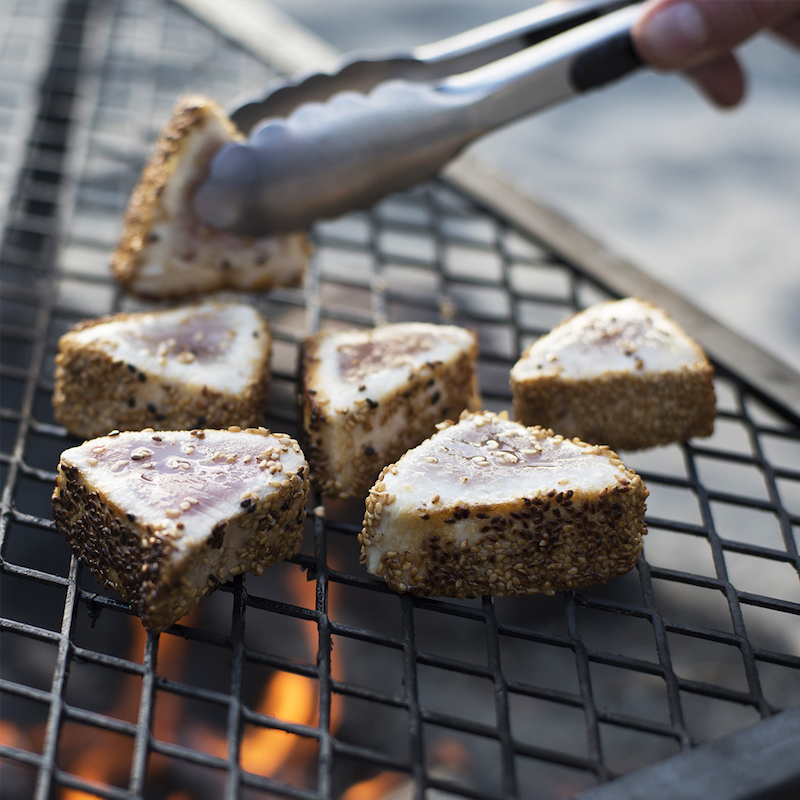Summer Seafood Grilling: Simple Tips
The basic rule - match the grilling method to the firmness of the seafood.
Jul 11, 2023
As balmy grilling weather envelops us, you may be dreaming of sizzling steaks, juicy chicken wings, and perfectly seared short ribs.
But let us add another savory delight to your summer grilling list: wild seafood.
Burgers may grab the spotlight, but fish, shrimp, scallops, and other ocean creatures have all the robust flavors and delightful textures you want from a grilled meal. And they are nutritious, to boot.
Try out quick and easy options like savory skin-on salmon fillets, hefty tuna steaks, and skewered scallops this summer. Or get a little fancier with grilled lobster tail or mussels.
But before you do, brush up on your grill skills with our quick guide to summer seafood grilling. And don't forget the lemon juice!
It's all in the preparation
Good grilled seafood starts before you even fire up the grill. If you're using fresh-frozen fillets, make sure to fully thaw them before cooking. Half-frozen fish is a quick ticket to a meal that's both charred on the outside and raw inside. If you have the time, give your fillets a full 24 hours in the refrigerator to thaw — the slow thaw lets the fish absorb the ice crystals.

Next up, the seasoning. There are any number of delicious seasoning mixes, marinades, and rubs out there, so don't be afraid to experiment. Resist the urge to use a heavy hand on the spices, though — too much flavoring can overpower the fish itself, drowning the savory notes of a sockeye salmon fillet or tuna steak. At their best, seasonings enhance flavor rather than cover it up. For a good starter option, try our Signature Organic Salmon Seasoning.
And don't be afraid to stick with the classics: Some salt, a grind of pepper, and a splash of fresh lemon juice make any quality fish sing, especially accented with smoky, savory flavors fresh off the grill.
Finally, don't neglect the grill itself. Make sure your grates are clean and free of any charred bits that might distract from your perfect fillet. Get your grill up to temperature before scouring the grates with a wire brush. It's not a bad idea to give your grill a more thorough cleaning once or twice a year, too.
Different fish, different techniques
You can cook almost any kind of seafood on the grill, but your choice of fish or shellfish might call for slightly different cooking techniques. Fish like wild salmon, albacore tuna, and mahi-mahi have firm texture and thick fillets. These can be easily cooked over an open flame on the grates to give them that unique grill-seared taste and texture.

More tender or flaky fish, like Alaskan cod or sablefish, might require a little extra care to ensure they don't fall apart on the grill, though. Consider cooking tender fish in a cast-iron skillet (it will also keep juices and marinades simmering). Or try a wooden plank, which imparts a rich, smoky flavor. You can also cook more delicate cuts in a foil packet, perhaps with additions like onions, corn, zucchini, bell pepper, and lemons or lime.
If you choose to serve shrimp, scallops, and other smaller pieces of seafood, pop them on a skewer to make turning them a breeze and to stop them falling through the grates. You can also skewer chunks of fish alongside hearty vegetables and other tasty additions for a fun cookout twist. (Don't forget to soak wooden skewers in water for at least half an hour beforehand so they don't catch fire.)
Grill guideline: high temp, short time
It's best to cook seafood on a grill at a higher temperature for a shorter time so it won't dry out or stick to the grill. Seafood should reach an internal temperature of 145 degrees Fahrenheit to ensure that it's safe — check it with a meat thermometer. Look for fish to turn white and opaque on the grill, and don't be afraid to make a small cut to peek at the inside.

It's wise to take fish off the grill a few seconds before you think it might be done. Seafood has so much water inside that it, like meat proteins, will continue cooking for a brief time even after being removed from the heat.
Just like when you grill a steak or burger, you don't want to flip your fish more than once — let it cook thoroughly on one side before turning. It takes a bit of practice to eyeball this perfectly, but you will feel like a seasoned grill master once you do. Many chefs find that flexible spatulas work much better for fish than rigid ones, as they slide under more delicate cuts without damaging them.
Final word
One final suggestion for perfectly tender grilled fish: Keep the skin on. Cooking fish with the skin intact is quite easy, and it holds moisture in while preventing the fish from charring on high heat. For best results, pat the skin dry beforehand, throw the fish on the grill skin-side-down, and resist the urge to move the fillet around a lot, to prevent it from tearing.
Once your juicy sockeye salmon fillets or perfectly roasted shrimp skewers are ready, slide them onto a platter, garnish with a few herbs or lemon slices, and get ready for a tasty feast. We bet you'll forget all about your oven (you know, that thing in your kitchen?).







